 W
WEdible seaweed, or sea vegetables, are seaweeds that can be eaten and used for culinary purposes. They typically contain high amounts of fiber. They may belong to one of several groups of multicellular algae: the red algae, green algae, and brown algae.
 W
WAlaria is a genus of brown alga (Phaeophyceae) comprising approximately 17 species. Members of the genus are dried and eaten as a food in Western Europe, China, Korea, Japan, and South America. Distribution of the genus is a marker for climate change, as it relates to oceanic temperatures.
 W
WAlaria esculenta is an edible seaweed, also known as dabberlocks or badderlocks, or winged kelp. It is a traditional food along the coasts of the far north Atlantic Ocean. It may be eaten fresh or cooked in Greenland, Iceland, Scotland and Ireland. It is the only one of twelve species of Alaria to occur in both Ireland and in Great Britain.
 W
WArame , sea oak is a species of kelp, of the brown algae, best known for its use in Japanese cuisine.
 W
WAscophyllum nodosum is a large, common cold water seaweed or brown alga (Phaeophyceae) in the family Fucaceae, being the only species in the genus Ascophyllum. It is a seaweed that only grows in the northern Atlantic Ocean, also known in localities as feamainn bhuí, rockweed, Norwegian kelp, knotted kelp, knotted wrack or egg wrack. It is common on the north-western coast of Europe including east Greenland and the north-eastern coast of North America, its range further south of these latitudes being limited by warmer ocean waters.
 W
WAsparagopsis taxiformis, formerly A. sanfordiana, is a species of red algae, with cosmopolitan distribution in tropical to warm temperate waters. Researchers have demonstrated that feeding ruminants a diet containing one to two percent red seaweed reduced their methane emissions by over 90 percent. Of 20 types of seaweed tested, A. taxiformis showed the most promise, with nearly 99 percent effectiveness.
 W
WCallophyllis variegata, commonly known as carola, is a type of edible seaweed, a member of the genus Callophyllis. Callophyllis variegata occurs in Concepción de Chile and other parts of South America such as Peru, the Falkland Islands, Tierra del Fuego. But also in New Guinea, South Africa, Australia, New Zealand, Alaska, St. Paul Island, Antarctic and subantarctic islands such as the Graham Land, Kerguelen, Macquarie Island, South Georgia, and the South Orkney Islands.
 W
WCaulerpa is a genus of seaweeds in the family Caulerpaceae. They are unusual because they consist of only one cell with many nuclei, making them among the biggest single cells in the world. A species in the Mediterranean can have a stolon more than 3 metres (9.8 ft) long, with up to 200 fronds. This species can be invasive from time to time.
 W
WCaulerpa lentillifera is a species of ulvophyte green algae from coastal regions in the Indo-Pacific. This seaweed is one of the favored species of edible Caulerpa due to its soft and succulent texture. It is traditionally eaten in the cuisines of Southeast Asia, Oceania, and East Asia. It was first commercially cultivated in the Philippines in the 1950s, followed by Japan in 1986. Both countries remain the top consumers of C. lentillifera. Its cultivation has since spread to other countries, including Japan, Vietnam, Taiwan, and China. C. lentillifera, along with C. racemosa, are also known as sea grapes or green caviar in English.
 W
WCladosiphon okamuranus is a type of edible seaweed in the genus Cladosiphon, naturally found in Okinawa, Japan. Most mozuku is now farmed by locals, and sold to processing factories. The main use of mozuku is as food, and as a source of one type of sulfated polysaccharide called Fucoidan, which is used as a cancer treatment aid and health supplement.
 W
WDurvillaea antarctica, also known as cochayuyo and rimurapa, is a large, robust species of southern bull kelp found on the coasts of Chile, southern New Zealand, and Macquarie Island. D. antarctica, an alga, does not have air bladders, but floats due to a unique honeycomb structure within the alga's blades, which also helps the kelp avoid being damaged by the strong waves.
 W
WDurvillaea chathamensis is a large, robust species of southern bull kelp endemic to the Chatham Islands of New Zealand.
 W
WDurvillaea fenestrata is a large, robust species of southern bull kelp endemic to the subantarctic Antipodes Islands of New Zealand.
 W
WDurvillaea incurvata is a large, robust species of southern bull kelp endemic to Chile.
 W
WDurvillaea poha is a large, robust species of southern bull kelp found in New Zealand.
 W
WDurvillaea potatorum is a large, robust species of southern bull kelp found in Australia.
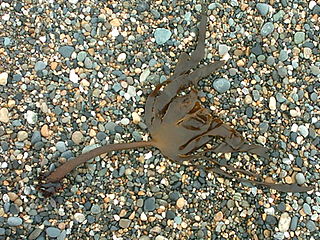 W
WEcklonia cava is an edible marine brown alga species found in the ocean off Japan and Korea. It is used as an herbal remedy in the form of an extract called Seanol, a polyphenolic extract, and Ventol, a phlorotannin-rich natural agent. Phlorotannins, such as fucodiphlorethol G, 7-phloro eckol, 6,6'-bieckol, eckol, 8,8'-bieckol, 8,4"'-dieckol and phlorofucofuroeckol A can be isolated from Ecklonia cava. Other components are common sterol derivatives.
 W
WFucus vesiculosus, known by the common names bladder wrack, black tang, rockweed, bladder fucus, sea oak, cut weed, dyers fucus, red fucus and rock wrack, is a seaweed found on the coasts of the North Sea, the western Baltic Sea and the Atlantic and Pacific Oceans. It was the original source of iodine, discovered in 1811, and was used extensively to treat goitre, a swelling of the thyroid gland related to iodine deficiency.
 W
WGim (김), also romanized as kim, is a generic term for a group of edible seaweeds dried to be used as an ingredient in Korean cuisine, consisting of various species in the genera Pyropia and Porphyra, including P. tenera, P. yezoensis, P. suborbiculata, P. pseudolinearis, P. dentata, and P. seriata.
 W
WGracilaria is a genus of red algae (Rhodophyta) notable for its economic importance as an agarophyte, as well as its use as a food for humans and various species of shellfish. Various species within the genus are cultivated among Asia, South America, Africa and Oceania.
 W
WGreen laver, known as aonori in Japan, sea cabbage (海白菜) in China, and parae (파래) in Korean, is a type of edible green seaweed, including species from the genera Monostroma and Ulva. It is commercially cultivated in some bay areas in Japan, Korea, and Taiwan, such as Ise Bay. It is rich in minerals such as calcium, magnesium, lithium, vitamins, and amino acids such as methionine. It is also called aosa in some places in Japan.
 W
WHijiki , sometimes called hiziki, is a brown sea vegetable growing wild on rocky coastlines of East Asia.
 W
WKaipen or kai paen is a Laotian snack made of fresh water green algae, garlic, vegetables, and sesame seeds.
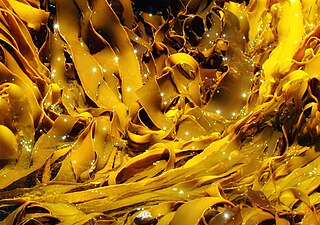 W
WKelps are large brown algae seaweeds that make up the order Laminariales. There are about 30 different genera. Despite its appearance, kelp is not a plant since it is not made of more than one clearly differentiated tissue; it is a heterokont.
 W
WKonbu is edible kelp mostly from the family Laminariaceae and is widely eaten in East Asia. It may also be referred to as dasima or haidai.
 W
WLaminaria digitata is a large brown alga in the family Laminariaceae, also known by the common name oarweed. It is found in the sublittoral zone of the northern Atlantic Ocean.
 W
WLaverbread is a food product made from laver, an edible seaweed consumed mainly in Wales as part of local traditional cuisine. The seaweed is commonly found around the west coast of Great Britain, and the coasts of Ireland where it is known as sleabhac. It is smooth in texture and forms delicate, sheetlike thalli, often clinging to rocks. The principal variety is Porphyra umbilicalis. Porphyra is classified as red algae; it tends to be a brownish colour, but boils down to a dark green pulp when prepared. Laver seaweed has a high content of dietary minerals, particularly iodine and iron. The high iodine content gives the seaweed a distinctive flavour in common with olives and oysters.
 W
WLimu, otherwise known as rimu or ʻimu is a general Polynesian term for edible plants living underwater, such as seaweed, or plants living near water, like algae. In Hawaii, there are approximately one hundred names for kinds of limu, sixty of which can be matched with scientific names. Hundreds of species or marine algae were once found in Hawaii. Many limu are edible, and used in the cuisine throughout most of Polynesia.
 W
WMeristotheca papulosa is a red alga, popular as a sea vegetable in Taiwan, where it is known as jiguancai, and in Japan, where it is known as tosaka-nori, which can be prefixed with aka (red) so as to distinguish it from the ao (green) and shiro (white) varieties.
 W
WNori (海苔) is a dried edible seaweed used in Japanese cuisine, made from species of the red algae genus Pyropia including P. yezoensis and P. tenera. It has a strong and distinctive flavor, and is often used to wrap rolls of sushi or onigiri.
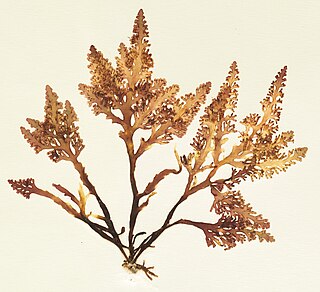 W
WOsmundea pinnatifida is a species of red alga known by the common name pepper dulse.
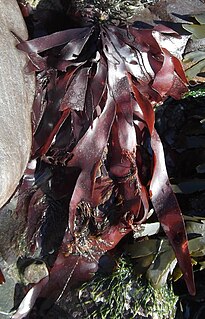 W
WPalmaria palmata, also called dulse, dillisk or dilsk, red dulse, sea lettuce flakes, or creathnach, is a red alga (Rhodophyta) previously referred to as Rhodymenia palmata. It grows on the northern coasts of the Atlantic and Pacific Oceans. It is a well-known snack food. In Iceland, where it is known as söl [ˈsœːl̥], it has been an important source of dietary fiber throughout the centuries.
 W
WOsmundea pinnatifida is a species of red alga known by the common name pepper dulse.
 W
WPorphyra is a genus of coldwater seaweeds that grow in cold, shallow seawater. More specifically, it belongs to red algae phylum of laver species, comprising approximately 70 species. It grows in the intertidal zone, typically between the upper intertidal zone and the splash zone in cold waters of temperate oceans. In East Asia, it is used to produce the sea vegetable products nori and gim. There are considered to be 60 to 70 species of Porphyra worldwide and seven around Britain and Ireland where it has been traditionally used to produce edible sea vegetables on the Irish Sea coast. Porphyra is a chief source of plant-based vitamin B12.
 W
WPostelsia palmaeformis, also known as the sea palm or palm seaweed, is a species of kelp and classified within brown algae. The sea palm is found along the western coast of North America, on rocky shores with constant waves. It is one of the few algae that can survive and remain erect out of the water; in fact, it spends most of its life cycle exposed to the air. It is an annual, and edible, though harvesting of the alga is discouraged due to the species' sensitivity to overharvesting.
 W
WPostelsia palmaeformis, also known as the sea palm or palm seaweed, is a species of kelp and classified within brown algae. The sea palm is found along the western coast of North America, on rocky shores with constant waves. It is one of the few algae that can survive and remain erect out of the water; in fact, it spends most of its life cycle exposed to the air. It is an annual, and edible, though harvesting of the alga is discouraged due to the species' sensitivity to overharvesting.
 W
WPyropia is a genus of red alga [seaweed] in the family Bangiaceae. It is found around the world in intertidal zones and shallow water. The genus has folding frond-like blades which are either red, brown or green. Some Pyropia species are used to create nori, and are thus important subjects for aquaculture.
 W
WPyropia tenera, also known as gim or nori, is a red algal species in the genus Pyropia. The specific name, tenera, means "delicate" and alludes to its small size. It typically grows to lengths between 20 and 50 cm. It is most typically found in the western Pacific Ocean and the Indian Ocean.
 W
WSaccharina japonica is a marine species of the Phaeophyceae plant, a type of kelp or seaweed, which is extensively cultivated on ropes between the seas of China, Japan and Korea. It is widely eaten in East Asia. A commercially important species, S. japonica is also called ma-konbu (真昆布) in Japanese, dasima (다시마) in Korean and hǎidài (海带) in Chinese. Large harvests are produced by rope cultivation which is a simple method of growing seaweeds by attaching them to floating ropes in the ocean.
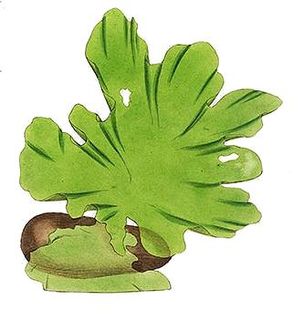 W
WThe sea lettuces comprise the genus Ulva, a group of edible green algae that is widely distributed along the coasts of the world's oceans. The type species within the genus Ulva is Ulva lactuca, lactuca being Latin for "lettuce". The genus also includes the species previously classified under the genus Enteromorpha, the former members of which are known under the common name green nori.
 W
WUlva intestinalis is a green alga in the family Ulvaceae, known by the common names sea lettuce, gutweed and grass kelp. Until they were reclassified by genetic work completed in the early 2000s, the tubular members of the sea lettuce genus Ulva were placed in the genus Enteromorpha.
 W
WUlva lactuca, also known by the common name sea lettuce, is an edible green alga in the family Ulvaceae. It is the type species of the genus Ulva. A synonym is U. fenestrata, referring to its "windowed" or "holed" appearance.
 W
WUlva linza is a green alga in the family Ulvaceae that can be found in British Isles.
 W
WUlva paschima is a green alga in the family Ulvaceae, a green seaweed endemic to the West Coast of India. The species was identified in 2014 based on molecular phylogenetics using ITS sequences as belonging to the “Paschima” clade.
 W
WWakame (Undaria pinnatifida) is a species of kelp native to cold, temperate coasts of the northwest Pacific Ocean. As an edible seaweed, it has a subtly sweet, but distinctive and strong flavour and texture. It is most often served in soups and salads.
 W
WSeaweed, or macroalgae, refers to thousands of species of macroscopic, multicellular, marine algae. The term includes some types of Rhodophyta (red), Phaeophyta (brown) and Chlorophyta (green) macroalgae. Seaweed species such as kelps provide essential nursery habitat for fisheries and other marine species and thus protect food sources; other species, such as planktonic algae, play a vital role in capturing carbon, producing up to 50% of Earth's oxygen.
 W
WWrack is part of the common names of several species of seaweed in the family Fucaceae. It may also refer more generally to any seaweeds or seagrasses that wash up on beaches and may accumulate in the wrack zone.